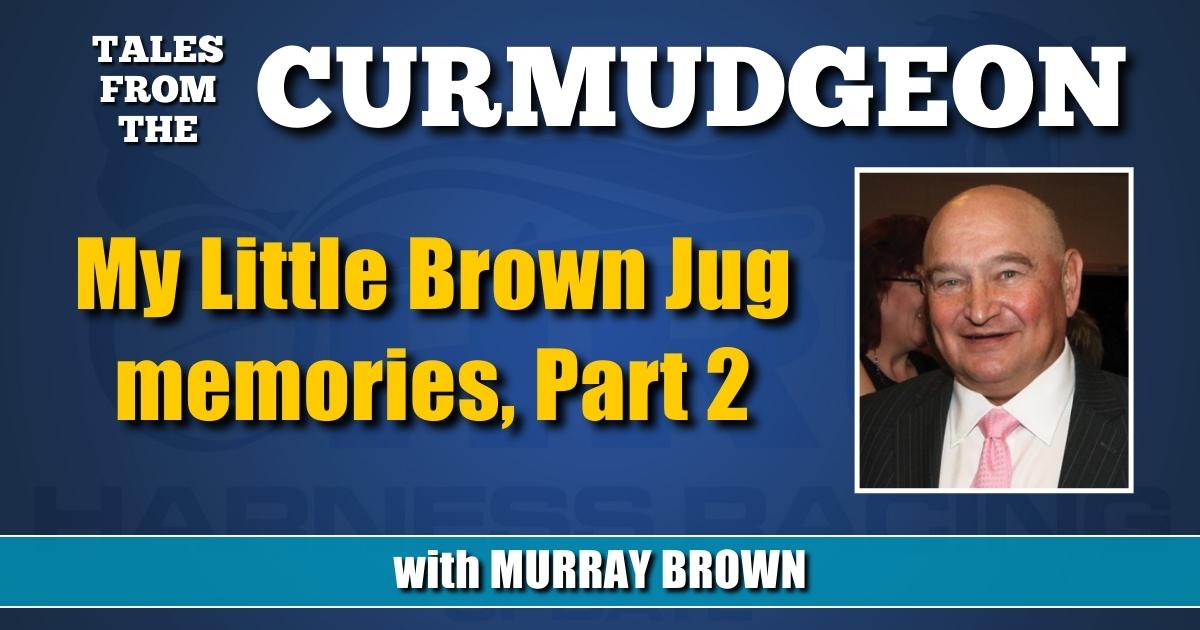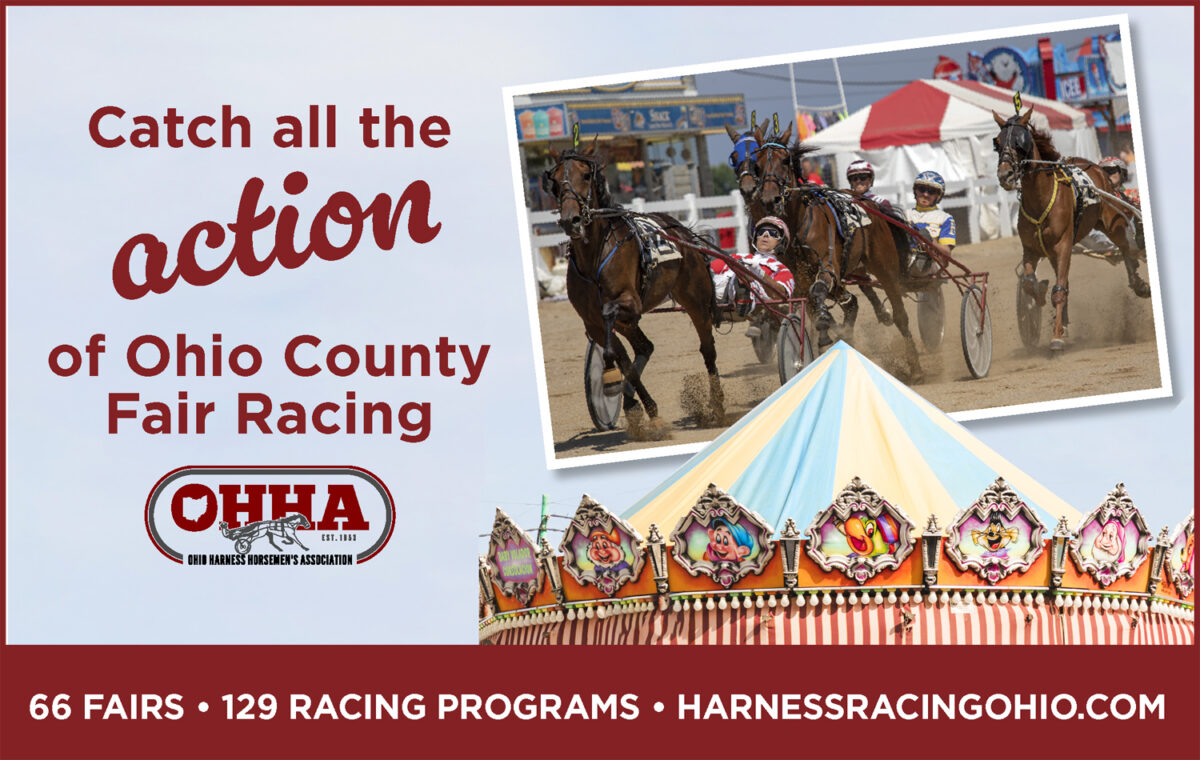

My Little Brown Jug memories, Part 2
by Murray Brown
Part 1 is here.
1967 — Best of All — There were two super colts in this division Romulus Hanover and Best Of All. Best Of All was the returning 2-year-old champion and was expected to dominate, but Romulus Hanover was yet to be heard from. He had been a slow learning 2-year-old, blessed with extreme speed, but questionable manners. At their best, Best Of All and Romulus Hanover dominated. The first important race of the year was the Messenger held at Roosevelt Raceway. Best Of All was heavily favored, but Romulus made a spectacular move from sixth to first in an eighth of a mile and just paced away from the field. The next important race was the first edition of The Adios held at The Meadows. Romulus and Best Of All were to do battle once again. Best Of All won the first heat and Romulus won the second. They came back for a raceoff which Romulus won in gate-to-wire fashion. Romulus appeared to be the champ at the time, but those in the know spoke of the nod in his gait. They met again in the Cane Pace at Yonkers with Romulus Hanover’s stable mate Meadow Paige victorious. Then on to Delaware, OH. Best Of All won the first heat. Another Haughton stable entrant Nardins Byrd won the next heat. Romulus Hanover, now obviously not himself was scratched from the final which was won by Ohio-owned, driven and trained Best Of All. One other note about Best Of All and Romulus Hanover. I’ve sometimes heard horsemen reject a yearling because it had long pasterns. Both Best Of All and Romulus Hanover had them. I remember Delvin Miller saying that long pasterns were a sign of high speed. He said that he never had one with long pasterns who wasn’t very fast.
1968 — Rum Customer — Billy Haughton entered the Jug with the two pre-race favorites in Rum Customer and Bye And Large. There were those that thought Bye And Large was the better of the two colts, but Haughton chose to drive Rum Customer assigning Bye And Large to his good friend George Sholty. It proved to be a fortuitous decision. In the first elimination Bye And Large jumped it off at the start and finished last. Ohio-owned longshot Adios Waverly picked up the pieces and won the heat at odds of 29-1. Rum Customer won the next elimination by open lengths and did the same in winning the final and the race. It wasn’t the best quality group to compete at Delaware. The best of the also rans were likely Batman, Bye And Large and Ozzie Hanover. Rum Customer was an excellent horse, yet history seems to have forgotten him. He was one of the first pacers to go over the million-dollar mark. In a twist of fate, he had been owned by long time Haughton patron Lloyd Lloyds. However early in the season he had lost his form. Lou Mancuso a pilot who Haughton had used was looking to get a horse. Lloyds was looking for an airplane. A deal was struck where Mancuso traded one of his planes for the then lightly raced Rum Customer. Mancuso got the best of the deal acquiring Rm Customer before the Jug and owned him for the majority of his racing career.
1969 — Laverne Hanover — My good friend Myron Bell often says, “The only places where crosses are of importance are in churches.” To some degree I agree with him. However, Tar Heel, the sire of 1969 Little Brown Jug winner Laverne Hanover could be described as the exception that proves the rule. The stud career of Tar Heel could be divided into two segments. The first began when he entered the stud at Hanover Shoe Farms in 1953. To a great degree he was bred to trottingbred mares who either couldn’t trot or those who showed a distinct proclivity to pace. That segment achieved success from the get-go. Among the great to good performers that came from those matings were Tarquinius, O’Brien Hanover, Bengazi Hanover, Tar Boy, Sunnie Tar and Penn Hanover. However, it was from the second segment of his career that Tar Heel reached true stardom; when he was bred to mares by the super sire Adios. Of all those stars, Laverne Hanover was the largest money winner with earnings of $868,557. But consider this: of Tar Heels seven greatest money winners, six of the seven were out of mares sired by Adios. The next two were out of mares by sons of Adios. If that isn’t proof of a real cross at work, I cannot come up with a better example.
Laverne Hanover kindles up fond memories for this guy. He together with the Triple Crown Winner Lindy’s Pride were part of my first yearling crop at Hanover. He was somewhat different than most Tar Heels that I had seen. Those out of the trottingbred mares were usually big and coarse. Laverne was smallish and somewhat streamlined in appearance. Billy Haughton bought him for $20,000, a fairly decent price for a yearling back then, for the account of Thomas W. Murphy, Jr. I recall Haughton saying that he was slow to hit the pace, but when he did, it was as though he had been doing it all of his life. He won the early stakes at Brandywine and Saratoga. At Saratoga, he became the first 2:00 2-year-old pacer on a half-mile track.
Now on to the Jug. Laverne came into the race as the favorite, but he was not without his share of issues which were inclined to whiten Haughton’s hair. Jug Day went well for Laverne and Haughton. The first elimination was won by Lightning Wave owned in partnership by my soon to be friend The Wizard, AKA Pacey Mindlin. Laverne Hanover won his first elimination but for a close call with Baker Lobell driven by Curly Smart. He then went on to easily win the final and the race.
1970 — Most Happy Fella — Much like the trotting threesome of Speedy Somolli, Florida Pro and Brisco Hanover of ١٩٧٨, the threesome of Most Happy Fella, Columbia George and Truluck preceded them on the pace. Most Happy Fella would win the most races, but Columbia George and Truluck were always around. It’s not a big secret that Stanley Dancer, Most Happy Fella’s trainer/driver throughout his career did not think as highly of his horse as he did with most of his other champions. I was a fly on the wall for two conversations that John Simpson had with Dancer. The first related to Simpson speaking with him with regard to possibly purchasing Most Happy Fella to stand at Hanover. “He’s a very good horse Johnny, but not a great one,” Dancer said. “You’ve got the horse that will, be the great sire in Columbia George. He is just about the gamest horse I’ve ever seen.” Dancer sold Most Happy Fella to Oscar Kimelman at Blue Chip Farms, saying it was the best piece of business he had ever done. It was a great piece of business but for Oscar Kimelman. The argument could be made that Most Happy Fella is the most influential sire of modern times. As for Columbia George, he wasn’t a failure in the stud barn, but he was not a success. The second conversation on which I eavesdropped related to Dancer’s comparing Most Happy Fella to his other great son of Meadow Skipper, Albatross. “There’s no comparison Johnny. Most Happy Fella is a top horse, but Albatross is a great one. Albatross cannot help becoming a great sire.” He was right there. Albatross and Most Happy Fella were both great sires and great broodmare sires. But Most Happy Fella’s male line remains current through the two branches from Western Hanover and Cam’s Card Shark.
Now to the race. To a great extent it was a duel between two great horses with bit parts played by Leander Lobell, Kentucky and Ferric Hanover. Most Happy Fella won the first heat. Columbia George won the second. Most Happy Fella came back to win the third heat in commanding style.
1971 — Nansemond — I suppose I›ve been colder, but never that I can readily remember. It was a cold, raw day in Delaware, OH in September 1971. Albatross might have been the greatest favorite in Little Brown Jug history if not for possibly Bret Hanover in 1965. But this Jug was not to end in the same manner as the one in 1965 did. Albatross was to be defeated by the fairly, to that time, unknown Tar Heel colt Nansemond. Why did this happen one might ask? It was likely one of two factors or most probably a combination of the two. The first reason was a young French Canadian driving genius named Herve Filion. My friend Andy Grant used to say when speaking of Filion, “He was born in a feed bucket.” He wasn’t too far from the truth. Filion was born into a harness racing family that consisted of eight boys, all of whom became drivers. Although all of the male Filions had talent in the bike, it was Herve who exceeded not only them, but quite possibly all other individuals who ever sat behind a trotter or pacer. He demonstrated his greatness from the time he was only 15 years old in winning driver’s championships year after year. On this day he would need all his genius to upset the mighty Albatross. The second reason was that Albatross just wasn’t himself on Jug Day. If he were, it’s my belief that he would have emerged with the Little Brown Jug trophy and the money and stature that went with it. Stanley Dancer, to his credit, took the blame for the defeat on his shoulders. Early in the season, he had promised the folks in Michigan that he would bring his champion to race there on the Saturday preceding the Jug. That night the weather was terrible and the track was very demanding. Albatross won, but Dancer felt it hadn’t left him sharp enough to go three heats in the Jug just five days later. As for the Jug itself, H.T. Luca won the first elimination. Albatross just nosed out Nansemond in the second. Then Nansemond bested Albatross in the third. The three heat winners came back for the raceoff which Nansemond won in convincing fashion.
1972 — Strike Out — Delaware, OH had never previously seen anybody or anything like John Hayes. Most horsemen of the harness variety are mostly closemouthed or even introverted. Not so Hayes! On his arrival at Delaware, Hayes was asked if he thought that his colt Strike Out could win the Little Brown Jug. His response: “I didn’t come to Ohio to run for governor.” When asked if he had given his driver Keith Waples any directions on how to drive the horse. “I told him to go forward and keep going; just be sure to make four left turns,” Hayes said. “Let me tell you something about Keith Waples. This guy is the greatest to ever sit behind a horse. Herve Filion has said that he idolizes him.” The home town favorite Jay Time came to the race as the pre-race chalk. He drew the 2-hole, but Strike Out had the rail. Strike Out parked Jay Time to the quarter in :27, the fastest in Jug history. Jay Time then faded to finish last and Strike Out won easily eclipsing his sire Bret Hanover’s world record. He then came back to win the second heat even easier than he had the first.
1973 — Melvin’s Woe — This was one of the few Jugs from ١٩٦٢ onward that I missed being at in person. On paper, it appeared to be a stellar group which included Armbro Nesbit, Faraway Bay, Ricci Rennie Time, Otaro Hanover, Keystone Smartie and Melvin’s Woe. But they were a beat-up group. Melvin’s Woe, the eventual race winner spent most of the three days he was in Delaware in a pair of ice boots. Each day, he would jog lame, but would apparently warm out of it when switching to the pace. Trainer Joe O’Brien’s suggestion to owner Thurman Downing was “Let’s try him a heat and then scratch.” They did and he won his elimination. The other elimination was won by Faraway Bay after making a sensational four deep rush around the last turn. It was back to the ice boots for Melvin’s Woe after his heat win. When they came out for the post parade for what was to be the final heat Melvin’s Woe still had a noticeable nod. O’Brien suggested that they race him. but protect him. Armbro Nesbit, stablemate to Melvin’s Woe, was cutting the mile and appeared to be a winner, when O’Brien appearing to be hopelessly boxed in, weaved some of the magic for which he was noted, managed to get free and come up the rail for the win.
1974 — Armbro Omaha — What would the odds be of the Jug being won by chestnuts three years in a row? Probably monumental. Unless the breed changes significantly, it will never happen again. But it did this year with Armbro Omaha following Strike Out and Melvin’s Woe. Today it’s almost as though we’ve bred chestnut pacers out of the breed. It’s exceedingly rare to even find one in the yearling catalogs of the two major sales. This year’s group was a decent group featuring Bret’s Star, Boyden Hanover and Armbro Omaha. Bret’s Star won the first elimination coming from off the pace and winning convincingly for Mike Gagliardi. In the second elimination Armbro Omaha out gutted Boyden Hanover to win going away. In the third and final heat Boyden Hanover cut the mile with Armbro Omaha first over and Bret’s Star following him on the rim. It appeared that Boyden was going to hold on, but right at the wire Armbro Omaha managed to just get by him for the win. I would recommend that any fan should watch the replay of this heat on YouTube where the commentary of the race is given by Billy Haughton.















